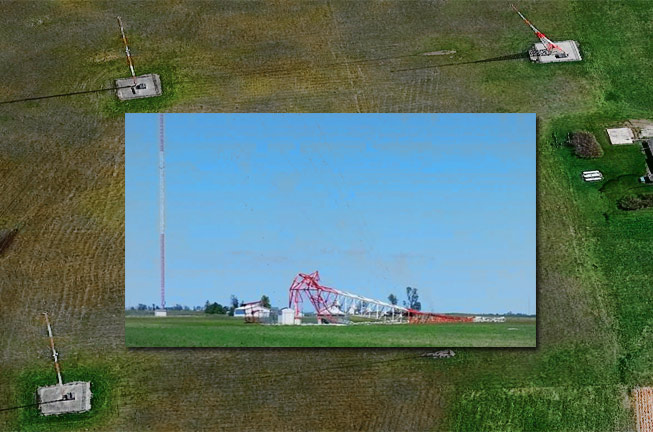
A Vertical Bridge self-supporting tower in a three tower array in Madison, Iowa (above) collapsed, but the two guyed towers weathered the high winds. KROS’s 400-foot tower, also in Iowa, collapsed from the storm. An American Tower 300-foot tower collapsed in Minnesota. Inset photo: Raleigh Reubenking
A 310-foot self-supporting tower owned by Vertical Bridge that broadcast WMT-AM radio’s signal throughout Iowa collapsed last week after tornado-type winds swept through Linn County.
According to the National Weather Service, a powerful line of severe thunderstorms known as “Derecho” tracked across Minnesotta, eastern Iowa, and northwest Illinois in the afternoon of August 10.
Straight line winds were estimated to be around 130 mph, a speed that would be equivalent to a strong EF2 tornado. Maximum measured wind gusts were at 112 mph.
An individual knowledgeable about the collapse said the structure was one of three AM towers in an array. The cleanup and the rebuilding process are already underway and a new tower is expected to be back up in less than 90 days.
So what wind speed was the tower designed for when it was erected? It will be difficult to tell since it was constructed in late 1940 when there was no recognized standard for communications towers.
The TR-116 Radio Transmitting Antennas and Supporting Towers for Radio Transmitting Antennas, at a cost of $.25, was the industry’s first standard published in 1949. Its lengthy title challenged its short content, four pages identifying a 20 psf design for structures up to 600 feet in non-city locations.
WMT reported in an FCC filing that its non-directional 5kW daytime tower was not damaged, but that the collapsed tower was part of its nighttime array. The FCC granted it special temporary authority to operate non-directionally with about a quarter of its normal power at night.
Further east in Clinton, radio station KROS lost its 400-foot guyed tower due to the storm. The structure was erected in 1947.
Storm is also unkind to American Tower
American Tower Corp. had the center 300-foot tower of a three-tower array collapse in New Hope, Minnesota. The tower was erected in 1961.
Asian American broadcaster KFXN-AM said the collapse severed their feed lines to the center and west towers and the station is currently operating with only the east tower at a reduced power of 120 watts.
The station received approval from the FCC to continue to operate non-directionally with a daytime power of 120 watts and non-directionally at night with a power of 4 watts, until the tower and feed line issues can be addressed.

















